The iPhone ClayTracker Takes on the Ruins of Lehigh Valley Sporting Clays
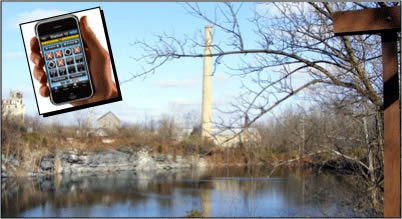
Imagine a game of sporting clays without the hassle of a clipboard and pencil.
As you walk up to the cage, you don’t have to search for a place to rest the clipboard that holds the score sheet. Where should I put it? Lean it against the gun rack? Balance it on the railing? Leave it in the cart and remember the scores to write down later? Hand it off to a friend who hands it to a friend and so on until eventually someone in the squad ends up dealing with the clunky thing?
And what about mistakes in scoring? How many times has the club given a pencil without an eraser? Have fun with that.
Then there’s the wind. It blows and lifts the score sheet off the clipboard, sends the pencil flying, as you scramble to grab everything without dropping your shotgun.
So when Shotgun Life Publisher, Irwin Greenstein, loaned me his Apple iPhone with ClayTracker software loaded on it I jumped at the chance. It was a good opportunity for me to give it a try before spending the $20 for my own copy.
What is ClayTracker?
It’s an iPhone application that lets you score sporting clays and 5-Stand (the company says it’s working on versions for Skeet, Trap and FITASC).
For me, the absolute best thing about ClayTracker is that it fits in your pocket and eliminates pencils and clipboards. The rest is icing on the cake.
For example, it keeps a running tally of your percentage of hits, it automatically rotates shooters in the squad, it helps determine which shots need the most practice (singles, report pairs, simo pairs, etc.) and it’s easy to correct any score keeping mistakes. It stores your previous score cards in case you want to go back and analyze your progress on a per-shot basis.
ClayTracker has integrated Help & Tips, Q&As and Sporting Clays Rules.
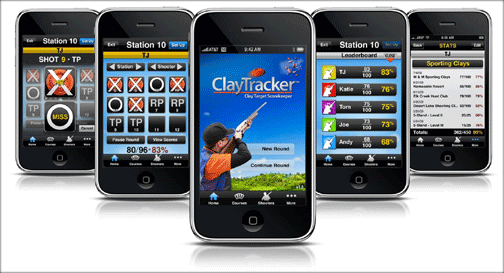
One of my favorite features turned out to be the integration of Google Maps. On the list of Clubs you had entered, you touch the arrow on the right to access Google Maps. The beauty of this is that you can plan a multi-club trip for a day or weekend using the driving directions (and see surrounding points of interest as well).
On the ClayTracker home page, you touch either New Round or Continue Round. If it’s a new round, you select the club and course, which you had previously entered. You also select the shooters. Under Select Shooters, naturally there’s information for the name but you can also enter a nickname and their National Sporting Clays Association membership number.
After that, you’re set to go until you actually arrive at the course, and then you’ll need to enter a few more data points to initiate the game.
Given the uniqueness of ClayTracker we decided to give it a test drive at the one-of-a-kind course at Lehigh Valley Sporting Clays in West Coplay, Pennsylvania.
Lehigh Valley Sporting Clays is located on a 125-acre abandoned limestone quarry – replete with all the old, ramshackle, cement buildings and quarry lakes.
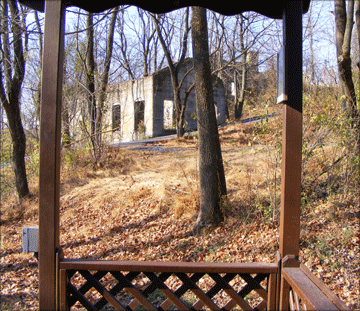
The quarry had once belonged to the Lehigh Portland Cement Co. The quarry plant dates back to the early 1900s, when Eastern Pennsylvania was America’s cement hub due to the plentiful deposits of limestone. By 1920 Lehigh Portland Cement was the largest cement company in the U.S., with annual production exceeding 12 million barrels of Portland cement.
By1927, the company’s operated 21 plants in10 states and generated revenues of more than $30 million. As the Great Depression gripped the nation, revenues declined to some $19 million in 1929. It was during this period that the West Coplay plant was abandoned, and left to ruin. Financially, Lehigh Valley Portland Cement peaked during the building boom that followed World War II, operating about eight plants. In 1977, it was purchased by German cement giant, Heidelberger Zement.
In 2000, high-tech entrepreneur and NRA supporter William A. Bachenberg took over the lease of the property from the previous owner and embarked on a massive improvement campaign. Over the years, he expanded the facility from the original five stations to the current 17, paved the trails and obviously maintains the place in top-notch condition.
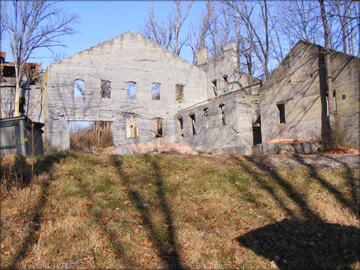
The clubhouse was modest and neat, with a small pro-shop. After checking in and getting a cart, we set up the ClayTracker.
On the home page screen, I touched New Round.
I touched Select Club And Course. It turns out that Irwin had already entered Lehigh Valley Sporting Clays. Importantly, he also included the number of stations (17). This is noteworthy as ClayTracker calculates your percentage of hits based on the total number of stations.
Then I touched Select Shooters. I added my name (my nickname was Lucky Strike for obvious reasons, and my shooting companion went by Quasar for less obvious reasons).
After you select the course and the shooters, touch Done and Station 1 automatically appears. What you’re looking at are 12 Chiclet-size buttons that you can set up for the individual shots at the station.
Just touch the Set-Up button on the top right and you’ll see the Shot Menu Set-Up.
S is for Single, FP is for Following Pair, RP is Report Pair, TP is True Pair and SP is for Simultaneous Pair. You enter the presentations for any individual station. Each shot can be different, so that on the first shot you have FP, second shot is RP and the third could be SP.
Throughout the course you can change each individual shot by touching it and then selecting whatever new presentation is appropriate; or if you you’re shooting the same type of shots throughout the course ClayTracker will repeat the presentation.
The ClayTracker automatically takes you to the scorekeeping screen for Station 1. You just select the appropriate presentation and the entire station is configured. If you change your mind and want to shoot FP instead of SP you can change it on-the-fly by simply touching the button.
Following each shot, you touch the big button on the screen to produce an X for a hit and an O for a miss. Made a mistake? Simply touch the X or O and it gives you the opportunity to correct the error.
After the first shooter is done, a screen appears that gives you the choice of Go To Next Shooter, Review Station, View Scores or Save Game For Later. I touched Go To Next Shooter and it was Quasar’s turn to keep my score as my own screen automatically popped up with the same presentations (which of course could be changed).
After the squad is done you are shown the option of Go To Next Station and then next shooter in the rotation comes up on the screen.
Let me say that it takes much, much longer to read this than to actually do it. The application is lightning quick, intuitive and easy to use. Best of all, the iPhone fit in the pocket of my shooting vest.
The one problem we did discover, though, was the glare of the sun. Depending on where you stood, the screen could be difficult to read because of the high-gloss finish on the iPhone screen.
That proved to be a minor distraction as we jumped into our cart and drove along the tarmac to Station 2. When you turn the corner the true history of the quarry is revealed. Station 2 has two cages, A (advanced) and B (beginner). Most of the stations incorporate A and B into a single, divided cage, but Station 2 had two distinct cages identified as A and B.
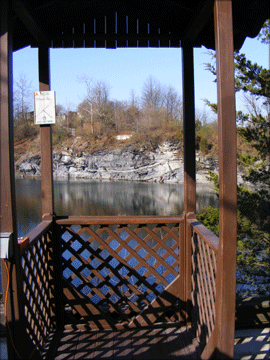
the quarry lake.
Anyway, when you turn the corner to Station 2 you see the quarry lake on your right and the remnants of an old industrial building on your left. Often, only the walls of the buildings are standing, some with gaping holes. Trees have grown around the buildings and if you’re a fan of post-apocalyptic landscapes you’ll be in heaven.
Station 2 shoots over a sparkling lake and across it you can see other ruins and tall, limestone cliffs.
There are no trappers at Lehigh Valley Sporting Clays. Each squad is given a controller. For our purposes, this gave us the chance to stress test the ClayTracker.
If you found the A report pair too easy you could pull it as a simo pair for an excellent set of targets. Of the six report pair at each station, you could shoot some on A and others on B. That means each station provided 10 different presentations depending on the sequence of the buttons you pushed on the controller. This variety clearly put ClayTracker through its paces and we quickly changed the presentations we shot during the score-keeping.
While a pencil and paper could certainly keep score, you would need someone who could write small and legibly to also make notations about what kind of shots were thrown. With ClayTracker, you pick the shot from the menu in as long as it takes to touch the correct button.
As we progressed through the course, it was absolutely incredible to have targets thrown through the buildings, from the windows and over water (with other ruins in the background).
And at the same time, here amid the ruins, we were keeping score with this brilliant digital device.
It was time to take this experience a step further…
Quasar was having some problems that day with their gun mount. I was able to use the camera in the iPhone to take photos of Quasar, who could in turn analyze their mount in real time and you could watch the precise percentage of their hits increase with each station. So you’re looking at the photos, operating ClayTracker, automatically calculating your score and when you took in the scenery you were surrounded by these tumbledown factory buildings and sparkling lakes.
We found ourselves in a sporting clays renaissance if you will.
All I can say is, it’s about time.
Noe Roland is a frequent contributor to Shotgun Life. You can reach him at letters@shotgunlife.com.
Useful resources:
ClayTracker
Lehigh Valley Sporting Clays


Comments